The business of pairing wine and food works somewhat like the institution of marriage. What they say about marriage holds good for wine. Just like for every eligible man there’s a woman somewhere out there, for every bottle of wine produced anywhere in the world, there’s a dish waiting to seduce it. And it’s this process of constant matchmaking that makes drinking wine an intensely engaging experience.
For a long time, the conventional wisdom on pairing Indian food with wine was that lassi and lager were the only drinks that married well with the ‘hotness’ of kebabs and curries. Then followed the grudging acknowledgement that the Gewürtztraminer (a white wine produced in Alsace, France) went well with Indian food because that’s what works with Thai curries.
There was a problem, though. The notion of one unifying Indian cuisine is a fallacy—even when we talk about Bangla Ranna, we talk about a medley of local influences, from Murshidabad and Hooghly to Kolkata and Dhaka, to Sylhet and Barisal. How can you have one wine that pairs well with the food of a nation where each state has a four to six distinctive cooking styles? And how can a wine that goes with Thai dishes, which use coconut milk, fish sauce (nam pla), lemongrass and kafir lime leaves, and have a completely different flavour profile, pair with this mythical entity called “Indian cuisine”?
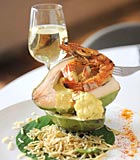 The demands of diversity
The demands of diversity
The notion was first challenged by Camellia Panjabi in her Fifty Great Curries of India, where each dish is paired with a wine in a category of its own. Some years later, Anjali Mendes, India’s first supermodel who was Pierre Cardin’s muse, did the same exercise in her French book of Indian recipes—La Cuisine Indienne—although her wine selection was limited to the offerings of Grover Vineyards.
Regional differences in produce, says Panjabi, is one driver of this culinary diversity. Rice-eating cultures, for instance, go for thinner gravies and those that subsist on wheat like their sauces to be thick and easy to handle with their breads— so now you know why we love our machher jhol and the nawabi families of Lucknow their fish musallam.
And among the host of other factors listed by Panjabi, “the restraining hand of Brahminism” explains why the “peasant food” of East Bengal doesn’t have the sweetness, which northerners find quite irritating, of the “bhadralok cuisine” of Kolkata, in the same way as the food that the Namboodiris eat in Kerala is milder than what the Syrian Christians make. How can one wine serve so many suitors?
“Gewurtztraminer? Have you ever enjoyed one with an Indian meal?” asks Brit wine writer Charles Metcalf, who did the wine and food pairing for Panjabi. I was asked the same question with similar contempt in Hong Kong by Jeannie Cho Lee, whose website asianpalate.com is a treasure trove of wine and food pairing ideas, but more from her a little later.
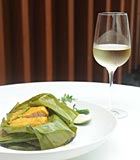 First, the ground rules
First, the ground rules
A man who knows the business of pairing better than most—his wife Kathryn and he had tested 27,000 food and wine matches over seven months for a pocket wine guide they were producing for Sainsbury, Metcalf repeats the elementary principle of this match-making: Check out the basic ingredient of the dish before you recommend a wine to go with it.
“A wine that goes with a yoghurt based dish may not work with a preparation where the main spice is cumin (zeera) or aniseed (saunf),” he says. Likewise, a red wine loaded with tannins can’t stand up to a chilli-hot attack, but a mellower, fruitier choice may just work.
Korean-born Jeannie, who’s a Master of Wine, a distinction that only 289 people from 23 countries have managed to get since 1955, goes into the intricacies of this pairing exercise from a regional perspective in her ground-breaking guide, Asian Palate: Savouring Asian Cuisine & Wine. “Wine is an experience, not a product,” Jeannie says. It’s a sentiment shared by wine aficionados around the world. And because wine is an experience, the act of pairing has to be an evolutionary process. But the ground rules haven’t changed. They are:
Rule no. 1: There’s no cuisine or dish that can’t be paired with a bottle of wine (though some people insist that the South Indian staples rasam and sambhar are impossible to find matches for). And there’s no unanimity yet on this rather contentious subject, so keep experimenting.
Rule no. 2: It’s the supporting cast of ingredients that should dictate wine pairing choices and not the meat or fish that is central to a dish. A tomato fish or butter chicken will have as smooth a marriage with a red wine as a meal of loochi and kosha mangsho, though the wine may be fruitier in the first instance and more full-bodied in the second.
Rule no. 3: There are notable exceptions to the first rule. I haven’t found an Indian match for Bordeaux’s celebrated reds or with the Barolos and the Barbarescos from Langhe in southern Piedmont. The complexity of these wines and the concentration of tannins in them, especially in their early years, make it impossible for them to get along with Indian dishes that come with their own medley of spices. It’s like forcing a marriage between two complicated people.
Rule no. 4: It’s my own blasphemous rule derived from the one before. Cheaper, younger, New World wines (especially those from Australia and Chile, besides the Indian of course) go best with Indian dishes. Look for wines in bottles with screwcaps—they’re usually uncomplicated that you can share with friends over a meal.
Rule no. 5: Avoid oaked wines. Their vanilla notes just don’t seem to agree with the bouquet of spices that comes with each Indian dish. Again, it’s like a marriage between two very complex people.
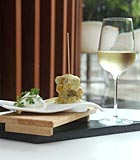 Pairing wine with Bangla Ranna
Pairing wine with Bangla Ranna
Before we set out on our adventure to pair wine with Bangla Ranna, let me first share some common sense I have acquired after years of imbibing the good stuff around the world and being paid to write about it.
The wines that work best for Indian dishes across regional denominations are crisp, dry whites with a mildly sweet finish—Riesling (the dry ones, such as those that the Germans label as Kabinett trocken), Gavi (an Italian wine from the Alessandria province of the Piedmont region, close to the Ligurian border) and Sauvignon Blanc. Fruit-forward reds—especially a Pinot Noir, an Aussie Shiraz (or a Cabernet Sauvignon-Shiraz blend) and a Tempranillo from the Rioja region of Spain—also mate well with a host of Indian dishes, from dal makhni to doi maachh.
The twist in the tale, in the case of Bangla Ranna, comes in the form of the paanch phoron, the delightful medley of fenugreek (methi), nigella seeds (kalonji or kalo jeera), cumin seeds (zeera), radhuni (from the apiaceae family) and fennel seeds (saunf). Each of the ingredients comes with its own taste profile, so if you wish to host a Bangla wine dinner, go slow on the paanch phoron and keep shukto out of the menu.
I wouldn’t also risk my neck suggesting a wine to pair with chorchori, chhechki and chhanchra. Nor would I demand that you have a wine with your aloo bhatey or mushurir dal. Why kill the simple joy of having these notables with a liquid accompaniment more elevated than water?
Mustard, the other Bengali favourite that turns even the sturdiest among us misty-eyed, does not come, thankfully, with the ‘I-insist-on-staying-single’ attitude, even if it is cooked in mustard oil. For the stronger shorshe machh, I’ll play safe and pair it with an easygoing Sauvignon Blanc (or maybe get a little adventurous and have it with a Beaujolais from Burgundy—but not the noveau, which is essentially a marketing gimmick).
With the milder (and steamed) machher paturi or bhapa chingri, where the mustard is underplayed, I will go ahead and order a Riesling. If it’s daab chingri, though, I will insist on a Gewürtztraminer, because this crisp white wine with lychee notes has a natural affinity to coconut milk, which is a key ingredient of the dish.
Now, what about chholar dal or ghoogni, or aloor dom? Tone down the sweetness of chholar dal if you wish to serve it with wine—a Riesling is its most eligible life partner. For a ghoogni, because of its tartness, I’d serve it with a Sauvignon Blanc or even unoaked Chardonnay from Margaret River, Australia.
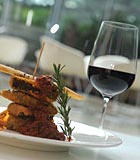 And aloor dom? For this foxy little thing, which walks the tightrope between mild sweetness and in-your-face pungency with the ease of a pro, I will demand an off-dry, or slightly sweet, Riesling or Gewürtztraminer. The two wines will get along like a house on fire with dhokar dalna. Aloo posto? Well, that’s a tricky customer.
And aloor dom? For this foxy little thing, which walks the tightrope between mild sweetness and in-your-face pungency with the ease of a pro, I will demand an off-dry, or slightly sweet, Riesling or Gewürtztraminer. The two wines will get along like a house on fire with dhokar dalna. Aloo posto? Well, that’s a tricky customer.
Have you noticed I haven’t recommended a red wine yet? Well, let’s start with a fruit-forward Pinot—not some expensive Burgundy label (imagine having a Domaine de la Romanee Conti!)—with chholar dal or dhokar dalna, and with vegetable chop, mangshor cutlet and the kabiraji, and deemer devil. For kathi rolls, I’ll stick with my most reliable ally, a Riesling. A cautionary note is in order here. If you serve these dishes with wine, avoid both ketchup and kashundi.
A Pinot (or better still, a Tempranillo) will do well with kosha mangsho too, but for potoler dolma, I’ll ask for a more rounded Cabernet Shiraz. For chitol machher muitha, though, I’ll do a Zindagi Na Milegi Dobara number and uncork a Tempranillo. For doi machh, my loyalty is divided between a Pinot and a Gavi. I have no such conflict of feelings in regard to the smoked hilsa. I’ll go for a Gavi.
The mutton rezala is a trickier treat. Like all things Awadhi, it comes with a complicated medley of spices—I’m especially worried about the javitri (mace) and the kewra (screwpine water), which make this an intensely aromatic dish. I’ll still be adventurous and settle for a Gavi—it’s acidity promises to cut into the yoghurt base of this preparation.
I have left the most contentious issue for the last. Is there a wine match for Bangla mishti? On this question, I agree with the western critics. You cannot pair dessert wine with most Indian sweetmeats because they’re too sweet—this overpowering sweetness, which is the hallmark of all good Bangla mishti flattens a dessert wine. A rosogolla or a mouchak is best had by itself.
Make this Durga Puja different. This is the time to eat, drink and celebrate. And believe me, there’s no better high than the one you get from a glass of wine. It’s, after all, the only alcoholic beverage you can have over a meal in the company of friend. Let the goddess be praised for the pleasures of life!
Wine recommendations
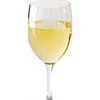 Whites Whites
-Sula Sauvignon Blanc 2010 Nashik
-
Grover Vineyards Viognier Clairette 2010 Nandi Hills
-Villa Maria Sauvignon Blanc Private Bin 2009 Marlborough (New Zealand)
-Dr Burklin-Wolf Estate Riesling 2009 Pfalz (Germany)
-Gavi di Gavi Marchesi di Barolo 2009 Barolo (Piemonte, Italy)
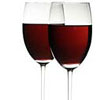 Reds Reds
-Sula Dindori Shiraz 2009 Nashik
-Grover Vineyards Cabernet Shiraz 2009 Nandi Hills
-Sutter Home Family Vineyards Cabernet Sauvignon 2008 Napa Valley (California)
-Kendall-Jackson Vintner’s Reserve Pinot Noir 2009 Sonoma County (California)
-D’Arenberg ‘The Laughing Magpie’ Shiraz Viognier 2008 McLaren Vale (Austral
|
Sourish Bhattacharyya is Executive Editor of Mail Today, and a wine aficionado and die-hard wine critic.

